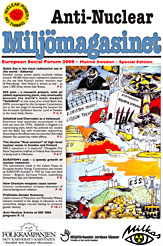Espoo convention
Baltic Sea Regional office of ECRR, Euradcom.org, submitted comments to the Espoo process in Latvia and even to the President and Prime Minister of Latvia suggesting to Veto final Nuclear Waste cemeteries in Sweden
Atklātā vēstule Vides Pārraudzības Valsts Birojam sakarā Forsmark 2
Earlier fr 31.12. 13 ECRR final till MMD om SKB SSM
Espoo participation of BSR countries in the Swedish EIA-procedures
In accordance with article 3 point 2 of the Convention of the Environmental Impact Assesment a Notification was sent by Sweden Dec 2005 to the countries around the Baltic Sea regarding their interest to participate in the EIA-procedure for the Encapsulation plant and the Final Repository for Spent Nuclear Fuel. Finlad, Germany, Lithuania, Poland and the Russian Federation expressed interest in participating in the consultations. Denmark, Estonia and Latvia wanted only to be informed.
http://www.skb.se/769dd7ad-059e-46c5-baf3-a9bd0133f43e.fodoc
http://www.skb.se/9cad1bc6-e17a-4189-a3ce-0cff6d497504.fodoc
Consultations are taking place in 2 steps: Background material for the first consultation is enclosed in the links above and the second consultation will take place after the EIA and permit applications are submitted, aproximately after march 2011. The preliminary Environmental Impact Statement, available only in Swedish, was published in the end of 2009 and and the whole public inquary process was finished at 6th 2010. (Download: http://www.skb.se/e772c90a-2015-4d8b-b259-80e5722de769.fodoc ) It had only 2 pages about radioactivity, and all incorrect information ( see http://www.bsrrw.org/?page_id=15 ).
The obligations of Parties to assess the Environmental Impact of certain activities at an early stage of planning
Below is a short extract from the Espoo Convention which quite clearly gives any neighbouring country the right to object. You can download the full legal document from the link below…
http://www.unece.org/env/eia/eia.htm
The Espoo (EIA) Convention of the United Nations stipulates the obligations of Parties to assess the environmental impact of certain activities at an early stage of planning.
It also lays down the general obligation of States to notify and consult each other on all major projects under consideration that are likely to have a significant adverse environmental impact across boundaries.
The Espoo Convention entered into force on 10 September 1997.
Article 15
SETTLEMENT OF DISPUTES
1. If a dispute arises between two or more Parties about the interpretation or application of this Convention, they shall seek a solution by negotiation or by any other method of dispute settlement acceptable to the parties to the dispute.
2. When signing, ratifying, accepting, approving or acceding to this Convention, or at any time thereafter, a Party may declare in writing to the Depositary that for a dispute not resolved in accordance with paragraph 1 of this Article, it accepts one or both of the following means of dispute settlement as compulsory in relation to any Party accepting the same obligation:
Submission of the dispute to the International Court of Justice
BSRRW comment:
BSRRW suggests the neighbouring countries to use the Espoo International Convention, which countries have all signed and aggreed on. Espoo Convention deals with big projects which can be expected to have transboundary, negative effects on neighbouring countries environment and on our common resource, our beautiful Baltic Sea.
If any one of the countries around the Baltic Sea – Denmark, Latvia or Norway for instance – would just put the Espoo Convention to it’s test, Sweden and Finland would have to store their spent fuel somewhere else than by the Baltic Sea (which is allready the most radioactive Sea in the world!) The coast of the Baltic Sea is the worst place to locate “final storages” of the most dangerous waste. The principal scientist of the Swedish Radiation Protection authorities has admitted in a private email to the member of BSRRW – that releases will end up in the Baltic Sea!
Our governments and the authorities, whose job it is to protect the people from radiation – should improve their performance and object to these existentially hazardous plans
For instance, Danish people are the worst affected and receive most radioactivity – allthough they have no nuclear power. So why do they not use the Espoo Convention to stop Sweden and Finland from destroying our ocean?

